

Siemens Digital Industries Software (formerly Siemens PLM Software) held its first virtual Media & Analyst conference on June 16th and 17th. This conference was the virtual version 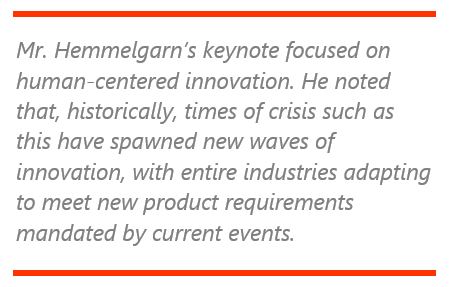
The event focused on Siemens’ Xcelerator portfolio that brings together and integrates the entire set of Siemens Digital Industries Software solutions. Embedded tools and databases connect current and future in-formation technology, operational technology, and engineering technology environments. Xcelerator combines key brands including Mind-Sphere, Teamcenter, Mentor, and Mendix. According to the company, these span the product design, simulation, manufacturing, and operations domains to enable clients to “design, realize, and optimize” across the product lifecycle.
Mr. Hemmelgarn’s keynote focused on human-centered innovation. He noted that, historically, times of crisis such as this have spawned new waves of innovation, with entire industries adapting to meet new product requirements mandated by current events. In the case of the current coronavirus pandemic, companies are producing ventilators instead of cars and personal protective equipment for healthcare workers instead of consumer goods. Mr. Hemmelgarn pointed out that the common thread that enables this rapid adaptation is a digital mindset.
Mr. Hemmelgarn went on to maintain that Siemens’ Xcelerator is the catalyst for the digital transformation. Xcelerator works by focusing on three primary areas of digital transformation: a comprehensive digital twin; personalized, adaptable, and modern solutions; and a flexible 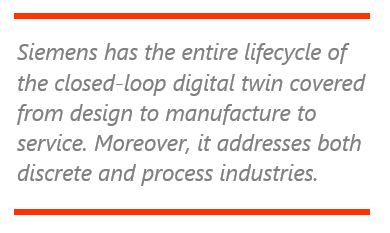
Mr. Hemmelgarn pointed out that these Siemens technologies and solutions go beyond the current crisis. Technology empowers humans’ need to have meaningful impact in the world. Siemens’ goal is to reframe innovation to keep up with ever changing needs of people and the planet.
Stuart McCutcheon, Global VP for Global Sales and Customer Success, presented a look at the digital twin in practice and how the implementation of the digital twin is driving real business value. Using the theme of Human-centered Innovation, McCutcheon examined several areas of industry, science, and society where the concept and practice of the digital 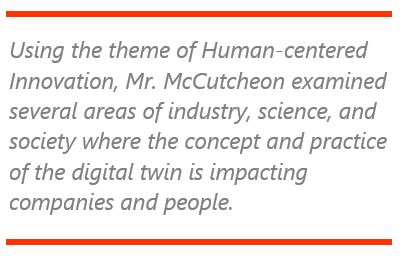
Mr. McCutcheon examined some of the tangible benefits of a digital twin: faster time to market and innovation, getting value from the huge amount of data generated from the industrial IoT, helping integrate engineering disciplines across the lifecycle, and supporting new business models. Siemens has a distinct view of what comprises a comprehensive digital twin: a precise virtual representation of a physical product or process used across its lifecycle to simulate, predict, and optimize the product and the production system. A digital twin is made up of multiple representations or models for different aspects of physical behavior and an evolving object that needs to be managed across the lifecycle. And lastly, a closed-loop digital twin provides for bi-directional connectivity between the physical asset and the virtual model.
Siemens is uniquely positioned to deliver a comprehensive digital twin. In the virtual world, this starts with the company’s mechanical and electrical product design solutions, comprehensive simulation platform solutions for design validation, production system simulation, validation, and virtual commissioning and then continues on to its factory floor as-built manufacturing process solutions and as-serviced solutions for products in the field. In the physical world, Siemens offers a range of solutions including R&D testing, product prototype testing, physical commission for production systems, automation and controls for 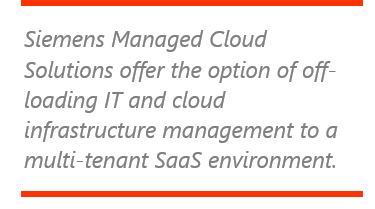
Mr. McCutcheon pointed out that today’s complex products that involve mechanical, electrical, and software design systems require a digital twin approach, both to validate the functionality of each engineering discipline and to integrate the various systems with model-based engineering methods. The digital twin validates the integration of engineering domains and the functionality of a complex product. Further, the digital twin environment uses data from the physical product to analyze and optimize the product in service.
Raymond Kok, SVP, Cloud Applications Solutions presented the current state of Siemens Digital Industries Software for cloud-based business solutions. Kok looked at how digitalization through the cloud is changing business models for the company’s customers. He also updated how Siemens’ MindSphere IoT operating system and the Mendix low-code development platform enable customers to make broad moves to cloud operations.
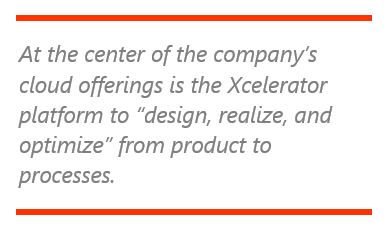
Customers with existing Siemens applications also have flexible deployment options. These include flexible deployment options for NX for product design, Teamcenter, Simcenter for product simulation, Opcenter, Polarion, and other product lifecycle solutions. Siemens Man-aged Cloud Solutions offer the option of off-loading IT and cloud infrastructure management to a multi-tenant SaaS environment. Cloud-connected services leverage the cloud for deployment, licensing (subscription), updates, and collaboration.
Mr. Kok announced that Teamcenter Share will be arriving later this summer. Share will allow customers to synchronize with cloud storage while working. It will also allow the user to view, measure, and mark up any CAD model on any device. Users will be able to review designs in augmented reality (AR) on smart phones and tablets.
The Xcelerator strategy is built on the cloud-based, Mendix low-code application platform. It covers multiple industry solutions, applications for collaboration, IoT analytics, operations, manufacturing, simulation, electronics, and mechanics. The Mendix platform allows customers to develop apps for product lifecycle, IoT, engineering and manufacturing, supply chain, finance or customer interaction. The development ser-vices include security, low-code development, and data integration. All of this is available on Siemens’ cloud services offerings. These include public, private, and managed cloud options, and are deployable on-premise and on the edge.
In keeping with the SaaS theme, Mr. Kok then turned to the Mind-Sphere IoT operating system to explore how MindSphere delivers industrial IoT as a cloud-based service. Working in conjunction with Mendix’s industry solutions and apps, MindSphere allows users to develop robust industrial IoT solutions and edge device management capabilities. According to Mr. Kok, MindSphere can provide connectivity for products, factories, plants, machines, production systems, and enterprise applications.
He explained that a comprehensive closed-loop digital twin is essentially a single interconnected twin with multiple views, all operating on a single collaborative platform across product, production, and performance. The digital twin is initiated with the virtual product design that specifies and meets requirements for fit, form, and function, while being concurrently validated through simulation models. The next phase of the lifecycle would be virtual production where manufacturing processes are validated and production systems commissioned virtually. Next, he moved into the physical world where real production takes place with automation and controls and then the product is delivered and serviced in the field. MindSphere is an integral component of the digital twin, delivering physical world analytical data to allow for process improvement and production optimization. These define the performance stage of the comprehensive digital twin.
Given the shortened agenda of the virtual event, Siemens Digital Industries Software managed to fit in a surprising amount of excellent content and articulate its solution strategies, products, platforms, and overall business message in a very concise and informative way. CEO and President, Tony Hemmelgarn’s theme of Human-centered Innovation struck a chord in the current time of global crisis and challenges facing businesses and manufacturers. His message was that transformation is now both an imperative and an opportunity. To that end, Siemens showed that it is offering a portfolio of technologies, solutions, and services with the potential to help manufacturing and other industries emerge from the current pandemic-related challenges and move forward with business as usual.
ARC Advisory Group clients can view the complete report at ARC Client Portal
If you would like to buy this report or obtain information about how to become a client, please Contact Us
Keywords: Xcelerator, Comprehensive Digital Twin, Cloud Solutions, Mendix, MindSphere, Digital Transformation, Human-centered Innovation, Siemens, ARC Advisory Group.

